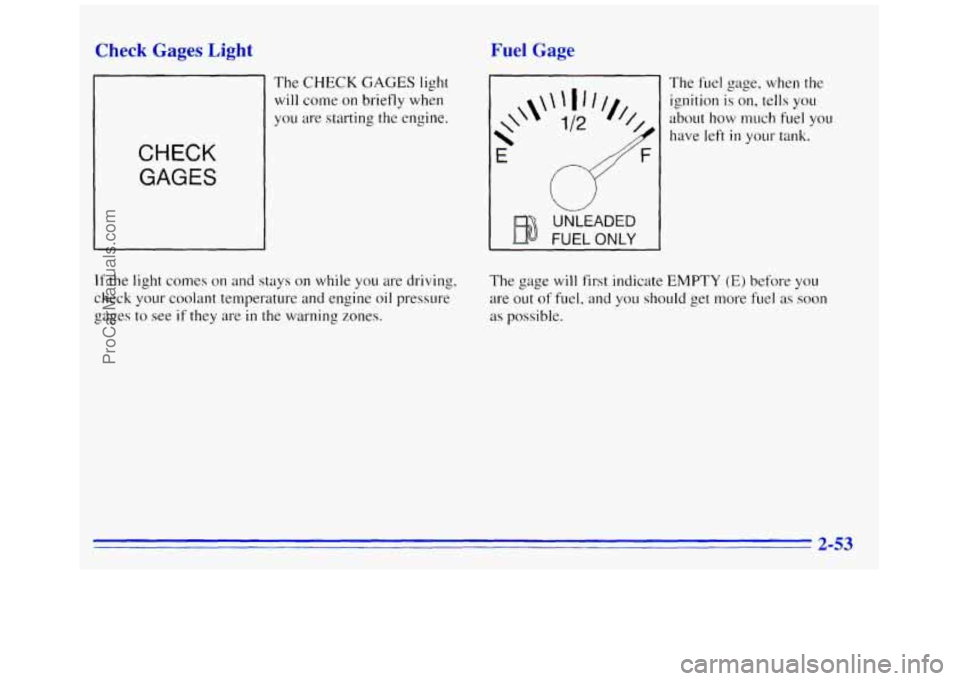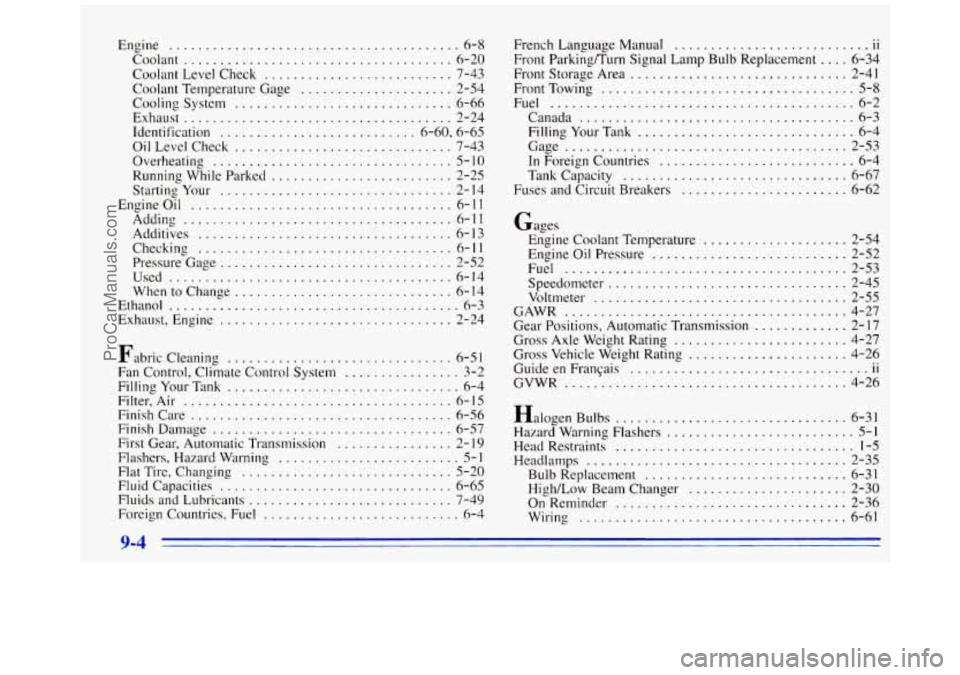1996 GMC SAVANA fuel pressure
[x] Cancel search: fuel pressurePage 7 of 372

Vehicle Symbols
These are some of the symbols you may find on your vehicle.
For example,
these symbols
are
used on an
original battery:
POSSIBLE A
CAUTION
INJURY
PROTECT EYES BY
SHIELDING
CAUSTIC
ACID COULD BATTERY
CAUSE
BURNS
AVOID
SPARKS
OR
FLAMES
SPARK
OR ,111,
COULD FLAME
EXPLODE BATTERY
These symbols are important for you and
your passengers
whenever your
vehicle
is
driven:
DOOR LOCK
FASTEN SEAT
BELTS
POWER
WINDOW
These symbols have
to do with
your lights:
SIGNALS e
TURN
RUNNING
* 0
DAYTIME . .
LAMPS -**
FOG LAMPS $0
These symbols
are
on some of
your controls:
WINDSHIELD
WIPER
WINDSHIELD DEFROSTER
VENTILATING FAN
These symbols
are used on
warning and
indicator lights:
COOLANT -
TEMP -
CHARGING I-1
BATTERY
SYSTEM
BRAKE
(a)
ENGINE OIL w,
PRESSURE
ANTI-LOCK
(@)
BRAKES
Here are some
other symbols
you may see:
FUSE
LIGHTER
m
HORN )cr
SPEAKER
b
FUEL ha
V
ProCarManuals.com
Page 111 of 372

Check Gages Light
The CHECK GAGES light
will come on briefly when
you are starting
the engine.
CHECK
GAGES
Fuel Gage
*
\\'
E
FUEL ONLY
UNLEADED
The fuel gage, when the
ignition is on, tells you
about how much
fuel you
have left
in your tank.
If the light comes on and stays on while you are dri\iing,
check your coolant temperature and engine oil pressure
gages to see
if they are in the warning zones. The
gage will first indicate
EMPTY (E) before you
are out
of fuel, and you should get more fuel as soon
as
possible.
2-53
ProCarManuals.com
Page 168 of 372

Once you are moving on the freeway, make certain
you allow a reasonable following distance. Expect to
move slightly slower at night.
When you want to leave
the freeway, move to the
proper lane well
in advance. If YOLI miss your exit, do
not, under any circumstances, stop and back up. Drive
on
to the next exit.
The exit ramp can be curved, sometimes quite sharply.
The exit speed is usually posted. Reduce your speed according
to your speedometer, not
to your sense of motion. After driving for any distance
at higher speeds,
you may tend to think you are going
slower than you actually are.
Before Leaving on a Long Trip
Make sure you’re ready. Try to be well rested. If you
must start when you’re not fresh
-- such as after a day’s
work
-- don’t plan to make too many miles that first part
of
the journey. Wear comfortable clothing and shoes you
can easily drive
in.
Is your vehicle ready for a long trip? If you keep it
serviced and maintained, it’s ready to go. If it needs
service, have it done before starting
out. Of course,
you’ll find experienced and able service experts
in GM
dealers
all across North America. They’ll be ready and
willing to help
if you need it.
Here are some things you can check before a trip:
0
0
0
0
0
0
0
Windshield Wclsher Fluid: Is the reservoir full? Are
all windows clean inside and outside?
Wiper- Blcrdes: Are they in good shape?
Fuel, Engine Oil, Other FlLtids: Have you checked
all levels?
Lnlnps: Are they all working? Are the lenses clean?
Tires: They are vitally important to a safe,
trouble-free trip.
Is the tread good enough for
long-distance driving? Are
the tires all inflated to the
recommended pressure?
Weather Forecasts: What’s the weather outlook
along your route‘? Should you delay your trip a short
time
to avoid a major storm system?
Maps: Do you have up-to-date maps‘?
4-20
ProCarManuals.com
Page 174 of 372

Run your engine only as long as you must. This saves
fuel. When you run the engine, make
it go a little fdster
than just idle. That
is, push the accelerator slightly.
This uses
less fuel for the heat that you get and it
keeps the battery (or batteries) charged. You will need
a well-charged battery (or batteries) to restart the
vehicle, and possibly for signaling later on with your
headlamps. Let the heater
run for awhile.
If you have a diesel engine, you may have to run it at a
higher speed to get enough heat. Then, shut the engine
off and close the window almost all the way to preserve
the heat. Start the engine again and repeat this only
when you feel really uncomfortable from the cold.
But
do it as little as possible. Preserve the fuel as long as you
can. To help keep warm, you can get out of the vehicle
and
do some fairly vigorous exercises every half hour or
so until help comes.
Loading Your T hicle
on
GAWR FRT
RIM COLD TIRE PRI
EE ~ENERS MANUAL FOR ADDITIONAL INFORMATION. -1
The CertificationRire label is found on the rear edge
of the driver’s door. The label shows the size
of your
original tires and the inflation pressures needed to obtain the gross weight capacity your vehicle. This is called
GVWR (Gross Vehicle Weight Rating). The GVWR
includes the weight of the vehicle, all occupants, fuel
and cargo.
4-26
ProCarManuals.com
Page 266 of 372

Inflation -- Tire Pressure
The Certification/Til-e-~ label, which is on the rear edge of
the driver’s door, shows the correct inflation pressures
for your tires when they’re cold. “Cold” means your
vehicle
has been sitting for at least three hours or driven
no 1mre than
1 mile (1.6 ktn).
NOTICE:
Don’t let anyone tell you that underinflation or
overinflation
is all right. It’s not. If your tires
don’t have enough air (underinflation), you can
get the following:
0 Too much flexing
Too much heat
0 Tire overloading
Bad wear
0 Bad handling
Bad fuel economy.
NOTICE: (Continued)
I NOTICE: (Continued) I
If your tires have too much air (overinflation),
you can get the following:
0 Unusual wear
0 Bad handling
0 Rough ride
0 Needless damage from road hazards.
When
to Check
Check your tires once a month or more.
Also, check the
tire pressure
of the spare tire.
Haw to Check
Use a
good quality pocket-type gage to check tire
pressure.
You can’t tell if yom tires are properly inflated
simply
by looking at them. Radial tires may look
properly inflated even
when they’re underinflated.
Be sure to put the valve caps back on the valve stems.
They help prevent leaks by keeping out dirt and moisture.
6-42
ProCarManuals.com
Page 340 of 372

At Least Once a Month Automatic Transmission Check
Tire Inflation Check
Make sure tires are inflated to the correct pressures. See
“Tires”
in the Index for further details.
Cassettt -1eck Service
Clean cassette deck. Cleaning should be done every
50 hours of tape play. See “Audio Systems” in the
Index for further details.
At Least Twice a Year
Restraint System Check
Make sure the safety belt reminder light and all bur
belts, buckles, latch plates, retractorshnd anchoiages are
working properly.
Look for any other loose or damaged
safety belt system parts. If you see anything that might
keep
a safety belt system from doing its job, have it
repaired. Have any torn or frayed safety belts replaced.
Also look for any opened or broken air bag covers, and
have them repaired or replaced. (The air
bag system
does
not need regular maintenance.) Check
the transmission fluid level; add if needed. See
“Automatic Transmission“
in the Index. A fluid loss
may indicate a problem. Check the system and repair
if needed.
At Least Once a Year
Key Lock Cylinders Service
Lubricate the key lock cylinders with the lubricant
specified
in Part D.
Body Lubrication Service
Lubricate ail hood hinges, hood prop rod pivot, fuel
filler door, rear compartment hinges, latches,
locks and
any moving seat hardware. Door hinges are lubricated
for the
life of your vehicle; no additional lubrication is
required. Part D tells you what to use. More frequent
lubrication may be required when exposed to a
corrosive environment.
7-44
ProCarManuals.com
Page 364 of 372

Engine ........................................ 6-8
Coolant ..................................... 6-20
Coolant Level Check
.......................... 7-43
Coolant Temperature Gage
..................... 2-54
Cooling System
.............................. 6-66
Exhaust
..................................... 2-24
Identification
........................... 6-60. 6-65
OilLevelCheck
.............................. 7-43
Overheating
................................. 5-10
Running While Parked ......................... 2-25
Starting Your
................................ 2- I4
Engine Oil
.................................... 6- 1 1
Adding ..................................... 6-11
Additives
................................... 6-13
Checking
................................... 6-11
Pressure Gage
................................ 2-52
Used
....................................... 6-14
Whentochange
.............................. 6-14
Ethanol
........................................ 6-3
Exhaust, Engine
................................ 2-24
Fabric cleaning
............................... 6-5 1
Fan Control. Climate Control System ................ 3-2
Filling
Your Tank ................................ 6-4
Filter. Air
..................................... 6-15
Finish Care
.................................... 6-56
Finish Damage
................................. 6-57
First Gear, Automatic Transmission
................ 2- 19
Flashers. Hazard Warning ......................... 5-1
Flat Tire. Changing ............................. 5-20
Fluid Capacities
................................ 6-65
Fluids and Lubricants
............................ 7-49
Foreign Countries. Fuel ........................... 6-4 French
Language Manual
11
Front Parkingnurn Signal Lamp Bulb Replacement .... 6-34
Front Storage Area
.............................. 2-41
FrontTowing
................................... 5-8
Fuel .......................................... 6-2
Canada
...................................... 6-3
.. ...........................
Filling Your Tank .............................. 6-4
Gage ....................................... 2-53
In Foreign Countries
........................... 6-4
Tankcapacity
............................... 6-67
Fuses and Circuit Breakers
....................... 6-62
Gages Engine Coolant Temperature
.................... 2-54
Engine
Oil Pressure ........................... 2-52
Fuel
....................................... 2-53
Speedometer
................................. 2-45
Voltmeter
................................... 2-55
GAWR
....................................... 4-27
Gear Positions. Automatic Transmission
............. 2-17
Gross Axle Weight Rating
........................ 4-27
Gross Vehicle Weight Rating ...................... 4-26
Guide en Franpis
11
GVWR ....................................... 4-26
Halogen Bulbs
................................ 6-31
Hazard Warning Flashers .......................... 5-1
Head Restraints ................................. 1-5
Headlamps .................................... 2-35
Bulb Replacement
............................ 6-31
High/Low Beam Changer
...................... 2-30
.. .................................
On Reminder ................................ 2-36
Wiring
..................................... 6-61
9-4
. .
ProCarManuals.com